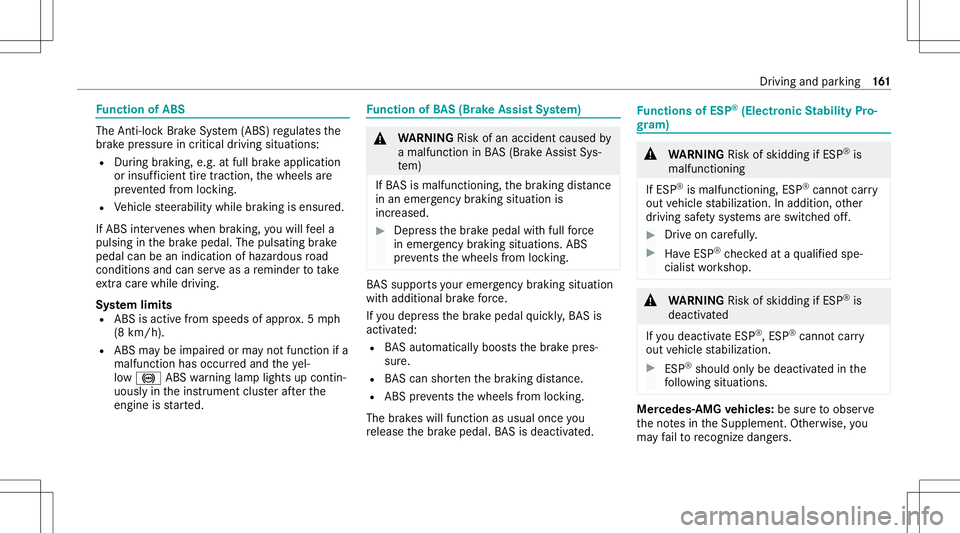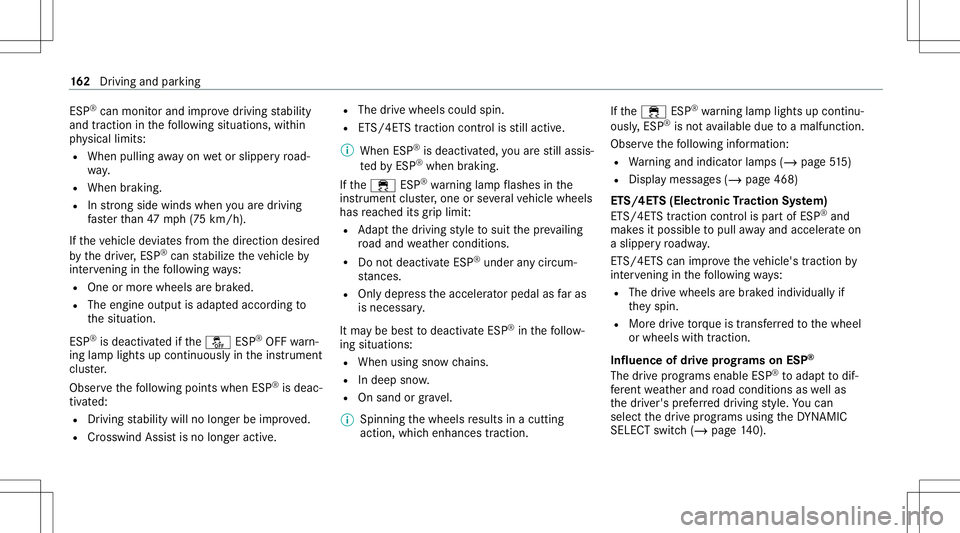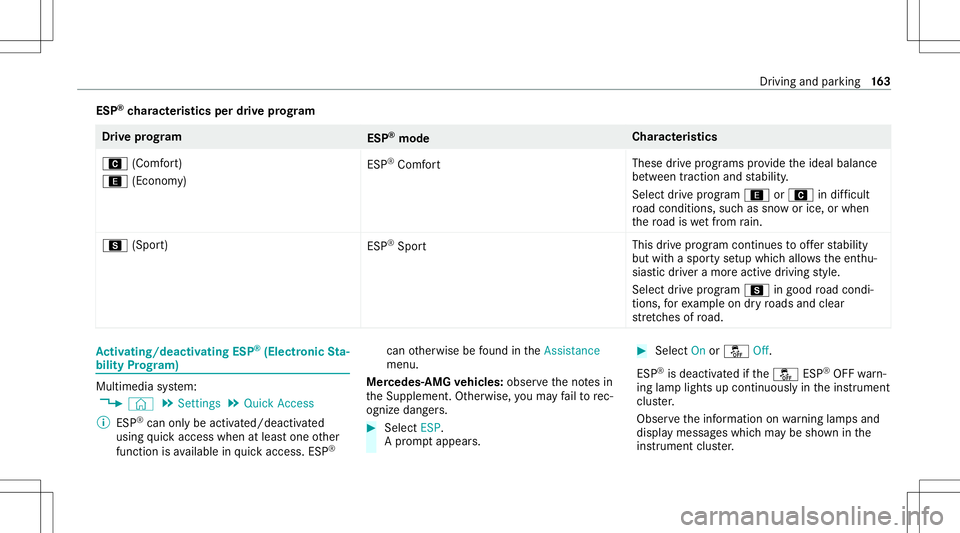2020 MERCEDES-BENZ A-CLASS SEDAN light
[x] Cancel search: lightPage 156 of 570

#
Hold remo tecontr ol5 atthesame angles
at various distances infront oftheinside
re ar vie wmir ror.Yo usho uld test eve ryposi‐
tion forat lea st25 seconds beforetrying
ano ther position . #
Notethat som ere mo tecontr olstransm it
only fora limi tedper iod, press butt on6 on
re mo tecontr ol5 again bef oretransm ission
ends . #
Align theant enn aline ofthedoor opener unit
wit hth ere mo tecontr ol.
% Supportand additiona linf ormati ononpro‐
gr amm ing:
R Ontheto llfree Hom eLink®
Ho tlin eon
1- 800 -355- 3515 .
R OntheInt erne tat htt ps:/ /
www .homelin k.com/me rcedes.
Opening orclosing thedoor
Re quirement s:
R The corresponding buttonisprogr ammed to
oper ateth edoor . #
Press and hold buttons 1,2or3 until
th edoor opens orcloses. #
Ifindicat orlam p4 flashes yello wafte r
appr oximat ely20 seco nds:pr ess and hold
th epr ev iousl ypr essed buttonagain untilth e
door opens orcloses. Clear
ingthega rage doo rope nermemo ry #
Press and hold buttons 1and 3.
Indicat orlam p4 lights upyello w. #
Ifindicat orlam p4 flashes gree n: release
butt ons 1and 3.
The entire memo ryhas been deleted.
Ra dio equipme ntappr oval number sfo rthe
ga rage doo rope ner 15
4
Driving and parking
Page 163 of 570

Fu
nction ofABS The
Anti-loc kBr ak eSy stem (ABS )re gulat esthe
br ak epr essur ein critical driving situation s:
R Dur ing braking, e.g.atfull brak eapplication
or insuf ficie nttiretracti on, thewheels are
pr eve nted from lock ing.
R Vehicle steer ability whilebraking isensur ed.
If ABS interve nes when braki ng, youwill feel a
pulsing inthebr ak epedal. Thepulsating brak e
pedal canbeanindicat ionofhazar dous road
con dition sand canserveas are minder totake
ex tra car ewh ile dr ivi ng.
Sy stem limit s
R ABSis act ive from speeds ofappr ox.5 mp h
(8 km/ h).
R ABSma ybe impair edorma yno tfunc tion ifa
malfunc tionhasoccurredand theye l‐
lo w 0025 ABSwa rning lam plight sup con tin‐
uousl yin theins trument clusteraf te rth e
engine isstar ted. Fu
nction ofBA S(Br akeAssis tSy stem) &
WARNIN GRisk ofan acci dent caused by
a malf unctionin BA S(Br akeAssi stSys‐
te m)
If BA Sis mal functi oning,th ebr aking distance
in an eme rgency braki ng situa tionis
incr eased . #
Dep ress thebr ak epedal withfull forc e
in emer gency braki ng situa tions. ABS
pr eve nts thewheels from locking . BA
Ssu ppo rts yo ur eme rgency braking situation
wit hadditional brak efo rc e.
If yo udepr essthebr ak epedal quickl y, BA Sis
acti vated:
R BASau tomatical lyboos tsthebr ak epr es‐
sur e.
R BAScan shorten thebr aking distance.
R ABS preve nts thewheels from locking .
The brak es will func tion asusual onceyo u
re lease thebr ak epedal. BASis dea ctivated. Fu
nctions ofESP ®
(Electr onicStabil ityPro‐
gr am) &
WARNIN GRisk ofskid ding ifESP ®
is
mal functi oning
If ESP ®
is mal functi oning,ESP ®
canno tcar ry
out vehicle stabiliz ation.Inaddit ion,ot her
dr iving safetysy stems areswitc hedoff. #
Drive on car efull y. #
Have ESP ®
ch eckedat aqu alif ied spe‐
cialis two rkshop. &
WARNIN GRisk ofskid ding ifESP ®
is
dea ctivated
If yo udeac tivateES P®
,ES P®
can notcar ry
out vehicle stabiliz ation. #
ESP®
shoul don lybe deactiv ated inthe
fo llo wing situat ions. Mer
cedes‑AM Gve hicl es:besur eto obser ve
th eno tesin theSupplement .Ot her wise, you
ma yfa ilto recogni zedangers. Dr
iving and parking 16
1
Page 164 of 570

ESP
®
can moni torand improve driving stabilit y
and tract ion inthefo llo wing situat ions,wit hin
ph ysical limit s:
R When pulling away on wetor slip pe ry road‐
wa y.
R When braking.
R Instro ng side winds when youar edr ivin g
fa ster than 47 mp h(7 5 km/h).
If th eve hicle deviat esfrom thedir ect ion desir ed
by thedr iver ,ES P®
can stabiliz eth eve hicle by
int erve ning inthefo llo wing ways:
R One ormor ewheels arebr ak ed.
R The engine outputisadap tedaccor dingto
th esituation .
ES P®
is deactiv ated ifth e00BB ESP®
OFF warn‐
ing lam plight sup con tinuousl yin theins trument
clus ter.
Obser vethefo llo wing pointswhen ESP®
is deac‐
tiv ated:
R Drivin gst abilit ywill nolongerbe improve d.
R Crosswind Assistis no long eractiv e. R
The drive wheels couldspin.
R ETS/4 ETStra ction control isstill act ive.
% When ESP®
is deact ivat ed, youar est ill assis‐
te dby ESP ®
wh en braki ng.
If th e00E5 ESP®
wa rning lam pflashes inthe
ins trumen tclus ter,one orseveralve hicle wheels
has reac hed itsgrip limit :
R Adaptth edr iving style to suit thepr ev ailin g
ro ad and weather condition s.
R Donotdeac tivateES P®
unde ran ycir cum ‐
st anc es.
R Onlydepr esstheacceler ator pedal asfaras
is necessar y.
It ma ybe bes tto deactiv ateES P®
in thefo llo w‐
ing situat ions:
R When usingsnowch ains .
R Indeep snow .
R Onsand orgrave l.
% Spin ningth ewheels results inacutting
action, whichenhances traction. If
th e00E5 ESP®
wa rning lam plight sup con tinu‐
ousl y,ESP ®
is no tav ailable duetoamalf unction.
Obse rveth efo llo wing informatio n:
R Warning and indic ator lam ps(/ page51 5)
R Displ aymessa ges(/ page468)
ET S/4ET S(Ele ctronic Tractio nSy stem)
ET S/ 4ETS tracti oncontr olispa rtof ESP ®
and
mak esitpossible topull away and accelerat eon
a slippe ryroadw ay.
ET S/4ET Scan improve theve hicle's traction by
int erve ning inthefo llo wing ways:
R The drive wheels arebr ak ed individually if
th ey spin.
R Mor edr ive to rq ue istrans ferred tothewheel
or wheels withtraction .
Influenc eof drive pr og rams onESP®
The drive pr ogr amsena ble ESP ®
to adap tto dif‐
fe re nt we ather and road con dition sas wellas
th edr iver's prefer reddr iving style. Youcan
sele ctthedr ive pr og rams using theDY NA MIC
SELE CTswitc h(/ page14 0). 16
2
Driving and parking
Page 165 of 570

ESP
®
ch aract eristics perdrive pr og ram Dr
ive pr og ram
ESP®
mod e Cha
racter istics
A (Comf ort)
; (Econom y) ES
P®
Comf ort Thes
edr ive pr og rams prov ide theideal balance
be tween traction and stabilit y.
Sel ect drive pr ogr am ; orA indifficult
ro ad con dition s,suc has snow orice, orwhen
th ero ad iswe tfr om rain.
C (Sport)
ESP®
Spor t This
drive pr ogr am continues toofferst abilit y
but withaspor tysetup whic hallo wstheent hu‐
sias ticdriver amor eactiv edr iving style.
Select drive pr ogr am C ingood road con di‐
tio ns,fo rex am ple ondryro ads and clear
st re tche sof road. Ac
tiv atin g/deac tivatin gES P®
(E lectr onicSta‐
bil ity Prog ram) Mu
ltimed iasystem:
4 © 5
Set ting s5
Quick Access
% ESP®
can onlybe activ ated/deact ivat ed
using quick acc ess when atleas tone other
funct ionisavailable inqu ick acc ess. ESP® can
other wise befound intheAssist ance
menu.
Mer cedes‑AMG vehicl es:obse rveth eno tesin
th eSupplement .Ot her wise, youma yfa ilto rec‐
ogni zedangers. #
Sele ctESP .
A pr om ptappear s. #
Select Onor00BB Off.
ES P®
is deac tivated ifth e00BB ESP®
OFF warn‐
ing lam plight sup con tinuousl yin theins trument
clus ter.
Obser vetheinf ormation onwarning lam psand
displa ymess ages whic hma ybe sho wninthe
ins trumen tclus ter. Dr
iving and parking 16
3
Page 166 of 570

Fu
nction ofESP ®
Cr osswind Assist ES
P®
Cr osswind Assistde tects sudde ngu stsof
side wind andhelps thedr iver tokeep theve hi‐
cle inthelane:
R ESP®
Cr osswind Assistis activ eat vehicle
speeds between appr ox.47 mp h(7 5 km/h)
and 125mp h(200 km/h) whendriving
st ra ight ahead orcor ner ing slight ly.
R The vehicle isstabiliz edbymeans ofindivi d‐
ua lbr ak eapp lication onone side. Fu
nction ofEBD (electr onicbrak efo rc edis‐
tr ibut ion) EB
Dis ch aract erize dby thefo llo wing:
R Mon itor ing and regulating thebr ak epr essur e
on there ar wheels .
R Improve ddr iving stabilit ywhen brakin g,
espe ciallyon ben ds. Fu
nction ofSTEER CONT ROL ST
EER CONTR OLhelpsyo uby trans mitting a
no tice ablesteer ing forc eto thesteer ing wheel in
th edir ect ion requ ired forve hicle stabiliz ation.
This steer ing recomme ndation isgiv en particu‐
lar lyin thefo llo wing situat ions:
R Both right wheels orboth leftwheels areon
a we tor slip pe ry road sur face whe nyo u
br ak e
R The vehicle star ts to skid
Sy stem limit s
ST EER CONTR OLmaybe impai redor ma yno t
func tion inthefo llo wing situat ions:
R ESP®
is deact ivat ed.
R ESP®
is malfun ctionin g.
R The steer ing ismalfunct ioning.
If ES P®
is malfunct ioning,youwill beassis ted
fur ther by theelectr icpo we rst eer ing. Fu
nction ofActiv eBr ak eAs sist Ac
tiveBr ak eAssi stconsi stsof thefo llo wing
func tions:
R Distance warning func tion
R Autonomo usbraki ng func tion
R Situ ation-d epend ent braki ng assist anc e
R Vehicl eswith Drivin gAss istanc ePa ck‐
ag e:Evasi ve Steer ing Assis t
Ac tiveBr ak eAssi stcan helpyo uto minimize the
ri sk ofacollision withve hicles, cyclis tsor
pedes trians, orreduce theef fects ofsuch acol li‐
sion .
If Ac tiveBr ak eAssi sthas detected arisk ofcolli‐
sion, awa rning tone sou nds and theL dis‐
ta nce warning lam plight sup intheins trument
clus ter.
Ve hicl eswith PRE-S AFE®
:depe nding onthe
cou ntry,an addit ionalhap ticwarning occursin
th efo rm ofslight, repeat edtensi oni ng ofthe
seat belt.
If yo udo notre act tothewa rning, autono mous
br akin gcan beinit iated incritic alsituat ions. 16
4
Driving and parking
Page 167 of 570

In
especia llycritical situations, ActiveBr ak e
Assi stcan initia te aut onomo usbrakin gdir ect ly.
In this case, thewa rning lam pand warning tone
occu rsi mu ltane ously with thebr aking applica‐
tion .
If yo uappl yth ebr ak eyo urself inacr itical situa‐
tio nor appl yth ebr ak edur ing autonomous brak‐
ing, situation -dependen tbr aking assistance
occu rs.The brak epr ess ureincr eases uptomax‐
imum full-sto pbr aking ifnec essar y. If
aut onomous braking orsitua tion-dependent
br aking assistance hasoccu rred, displa y1
appear sin themultifunc tiondispla yand then
aut omaticall ygoes outafte ra shor ttime. If
th eaut onomous braking function orthesitua‐
tion -dependen tbr aking assistance istrig ge red,
additional preve ntiv emea suresfo roccupa nt
pr otect ion (PRE-S AFE®
)ma yalso beinitiat ed. &
WARNIN GRisk ofan acci dent caused by
limit eddetection perform anc eof Active
Br ak eAssi st
Ac tiveBr ak eAssi stcanno tal wa ys cle arly
ident ifyobje ctsand complextraf fic situ a‐
tions .
In such case s,Ac tiveBr ak eAssi stmight :
R Giveawa rning orbrak ewit hout reason
R Notgiv eawa rning ornotbr ak e #
Alw ayspa ycar eful attention tothetra f‐
fi c situ ation; donotre ly on ActiveBr ak e
Assi stalon e.Ac tiveBr ak eAssi stisonl y
an aid. Thedriver isresponsible for
maint ainingasui table distance tothe
ve hicle infront, vehicle speed andfor
br aking ingood time. #
Beprepar edtobrak eor sw erve ifnec ‐
essar y. %
Ifth esy stem isuna vailable, the00D4 displa y
appear sin themultifunc tiondispla y.
Als oob ser vethesy stem limits ofActiveBr ak e
Assi st.
The indiv idua lsub functionsar eav ailab lein
th efo llo wing speed rang es:
The distance warning func tion issues awa rning
in thefo llo wing situat ions:
R From appr oximat ely4 mp h(7 km/h), ifyo ur
ve hicle iscritically closetoave hicle or
pedes trian, youwill hear anintermit tent
wa rning tone and theL distance warning
lam plight sup intheins trument cluster.
Ve hicl eswith PRE-S AFE®
:depe nding on
th ecount ry,an addition alhap ticwarning
occ ursin thefo rm ofslight, repeat edten‐
si oni ng oftheseat belt.
Br ak eimmediat elyortake evasiv eact ion,pr ov i‐
ded itis saf eto do soand thetra ffic situat ion
allo wsthis. Dr
ivin gand parking16
5
Page 171 of 570

R
Activati on byan abr uptst eer ing movement
dur ing asw erving maneu ver.
R Assi stanc edur ing swervin gand stra ight enin g
of theve hicle.
R React ion from aspee dof appr oximat ely
12 mp h(20 km/h) uptoaspee dof appr ox‐
imat ely43 mph(70 km/h).
Yo ucan preve nttheassis tance atanytime by
act ivel yst eer ing. &
WARNIN GRisk ofan acci dent despite
Ev asive St eer ing Assis t
Ev asiv eSt eer ing Assis tcann otalw aysclear ly
ident ifyobje ctsand complextraf fic situ a‐
tions .
In addition, thesteer ing suppor tof Evasiv e
St eer ing Assis tis ge ner ally no tsu fficien tto
av oid acollision.
In suc hcases Evasiv eSt eer ing Assis tcan:
R givean unnec essarywa rning orprov ide
assis tance R
notgi ve awa rning ornotpr ov ide assis‐
ta nce #
Alw ayspa ycar eful attention tothetra f‐
fi c situ ation; donotre ly on Evasiv e
St eer ing Assis talone. #
Beready tobrak eand take evasiv e
act ion ifnec essar y. #
Preve nttheassis tance byact ivel y
st eer ing innon -critical driving situa‐
tion s. #
Drive at an appr opriatespeed ifpedes‐
tr ians areclose tothepat hof your vehi‐
cle. Sy
stem limit s
Fu llsy stem perform anc eis no tav ailable fora
fe w sec ond saf te rswitc hingontheignition or
af te rdr iving off.
The system maybe impair edorma yno tfunc tion
in thefo llo wing situat ions:
R Insno w,rain, fog, hea vyspr ay,if th er eis
gl ar e, indir ect sunlight oringrea tly varying
ambien tlight . R
Ifth esensor sar edir ty,fo gg ed up, damag ed
or covered.
R Ifth esensor sar eim pair eddue tointerfer‐
ence from other radar sour ces, e.g.stro ng
ra dar reflect ions inpar king garage s.
R Ifaloss oftirepr essur eor afa ulty tirehas
been detected and displ aye d.
R Incom plextraf fic situ ations whereobject s
cann otalw aysbe clear lyidentif ied.
R Ifpedes trians orvehicles movequickl yint o
th esensor detection rang e.
R Ifpe destrians arehidde nby other objects .
R Ifth etypical outline ofapedes trian cann ot
be distinguished from thebac kground.
R Ifapedes trian isno tde tected assuch ,e.g.
due tospecial clothing orother object s.
R Onbends withatight radius.
% The ActiveBr ak eAssi stsensor sadjus taut o‐
matically whileacer tain dis tance isbe ing
dr iven afte rth eve hicle hasbeen delivered.
Ac tiveBr ak eAssi stisuna vailable oronl y
par tiall yav ailable during this teac h-in per iod. Dr
ivin gand parking16
9
Page 173 of 570

%
The segment sbe tween thestor ed speed and
th eend ofthesegment displaylight upin
th espeedome ter.
Sy stem limit s
Cr uise control ma ybe unable tomaint ainthe
st or ed speed onuphill gradients. Thestor ed
speed isresumed whenthegr adient evensout.
Ch ang eint oalowe rge ar ingood timeon long
and steep downhill gradients. Take par ticular
no te ofthis when drivin galaden vehicle. By
doing so,youwill mak euse oftheengine' sbr ak‐
ing effect. Thisre lie vesth eload onthebr ak e
sy stem and preve nts thebr ak es from overheat‐
ing and wearing tooqu ickl y.
Do notus ecr uise contr olinthefo llo wing situa‐
tion s:
R Intraf fic situ ations whichrequ ire freq uent
ch ang esofspee d,e.g .in hea vytraf fic, on
wi nding roads.
R Onslippe ryroads. Accel erati ng can cause
th edr ive wheels tolose tract ion and the
ve hicle could then skid.
R Ifyo uar edr ivin gwhen visibilit yis poor . Ope
ratin gcr uis eco ntr ol &
WARNIN GRisk ofacci dent dueto stor ed
speed
If yo ucall upthestor ed speed andthis is
lo we rth an your cur rent spe ed,th eve hicle
deceler ates. #
Take intoacc ount thetra ffic situat ion
bef orecallin gup thestor ed speed. Re
quirement s:
R ESP®
mus tbe act ivat ed, but notint erve ning .
R The driven spe edisat leas t15 mp h
(20 km/ h).
R The transmis sionisin positio n005B. #
Toactiv atecr uise contr ol: press rock er
switc h1 up. #
Toactiv atecr uise contr ol: press rock er
switc h2 up(SET +)or down (SET -).
The current spe edisstor ed and maint ained
by theve hicle.
or Dr
iving andparking 17
1